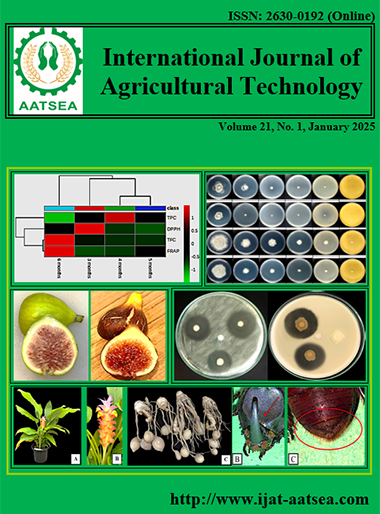Larvicidal and pupicidal activity of combination of two plant essential oils against Aedes aegypti
Main Article Content
Abstract
The larvicidal and pupicidal effects of six mixtures of cinnamon (Cinnamomum verum J. Presl.) and nutmeg (Myristica fragrans Houtt.) essential oils (EOs) and major compositions (geranial, α-pinene and trans- cinnamaldehyde) were tested against early fourth instar and pupal stages of Aedes aegypti. The combinations (2% cinnamon EO + 1% geranial, 2% cinnamon EO + 1% trans-cinnamaldehyde and 2% cinnamon EO + 1% α-pinene) showed high toxicity against early 4th instar larvae, with 100% mortalities at 24 hours and LT50 between 1.4 and 2.4 hours. Additionally, 2% nutmeg EO + 1% α-pinene showed >99% mortality at 24 hours with LT50 = 4.6 hours. 2% nutmeg EO + 1% geranial and 2% nutmeg EO + 1% α-pinene were highly toxic against pupae, with 100% mortality at 48 hours and LT50 values of 5.8 and 7.8 hours. On the other hand, temephos showed LT50 for larval and pupal stages at 9.8 and 94.1 hours. It showed that 2% nutmeg EO + 1% α-pinene was able to control immature stages and was more effective than temephos. However nutmeg extracts need to be checked for human and valuable species toxicity.
Article Details

This work is licensed under a Creative Commons Attribution-NonCommercial-NoDerivatives 4.0 International License.
References
Abou-Elnaga, Z. S. (2014) Insecticidal bioactivity of eco-friendly plant origin chemicals against Culex pipiens and Aedes aegypti (Diptera: Culicidae). Journal of Entomology and Zoology Studies, 2:340-347.
Ahebwa, A., Hii J., Neoh K. B. and Chareonviriyaphap, T. (2023). Aedes aegypti and Aedes albopictus (Diptera: Culicidae) ecology, biology, behaviour, and implications on arbovirus transmission in Thailand: Review. One Health, 16:100555.
Aungtikun, J., Soonwera, M. and Sittichok, S. (2021). Insecticidal synergy of essential oils from Cymbopogon citratus (Stapf.), Myristica fragrans (Houtt.), and Illicium verum Hook. f. and their major active constituents. Industrial Crops and Products, 164:113386.
Beltrán-Silva, S. L., Chacón-Hernández, S. S., Moreno-Palacios, E. and Pereyra-Molina, J. A. (2016). Clinical and differential diagnosis: dengue, chikungunya and Zika. Revista Médica Del Hospital General De México, 81.
Benelli, G., Lo Iacono, A., Canale, A. and Mehlhorn, H. (2016). Mosquito vectors and the spread of cancer: An overlooked connection. Parasitology research, 115:2131-2137.
Carolina, A. and Maman, M. (2016). Larvicidal Activity of Essential Oils from the Leaves and Fruits of Nutmeg (Myristica fragrans Houtt) Against Aedes aegypti (Diptera: Culicidae). Turkish Journal of Agriculture- Food Science and Technology, 4:552-556.
Champasuri, S. and Itharat, A. (2016). Bioactivities of Ethanolic Extracts of Three Parts (Wood, Nutmeg and Mace) from Myristica fragrans Houtt. The Journal of Medical Association of Thailand, 99:S124-S130.
Conti, B., Flamini, G., Cioni, P.L., Ceccarini, L., Macchia, M. and Benelli, G. (2014). Mosquitocidal essential oils: Are they safe against non-target aquatic organisms?. Parasitology research, 113:251-259.
Cossetin, L. F., Santi, E. M. T., Garlet, Q. I., Matos, A. F. I. M., De Souza, T. P., Loebens, L., Heinzmann, B. M. and Monteiro, S. G. (2021). Comparing the efficacy of nutmeg essential oil and a chemical pesticide against Musca domestica and Chrysomya albiceps for selecting a new insecticide agent against synantropic vectors. Experimental Parasitology, 225:108104.
Elumalai, D., Hemavathi, M., Hemalatha, P., Deepaa, C. V. and Kaleena, P. K. (2016). Larvicidal activity of catechin isolated from Leucas aspera against Aedes aegypti, Anopheles stephensi, and Culex quinquefasciatus (Diptera: Culicidae). Parasitology research, 115:1203-1212.
Gomes da Rocha Voris, D., Dos Santos Dias, L., Alencar Lima, J., Dos Santos Cople Lima, K., Pereira Lima, J. B. and Dos Santos Lima, A. L. (2018). Evaluation of larvicidal, adulticidal, and anticholinesterase activities of essential oils of Illicium verum Hook. f., Pimenta dioica (L.) Merr., and Myristica fragrans Houtt. against Zika virus vectors. Environmental Science and Pollution Research, 25:22541-22551.
Jung, W. C., Jang, Y. S., Hieu, T. T., Lee, C. K. and Ahn, Y. J. (2007). Toxicity of Myristica fragrans Seed Compounds Against Blattella germanica (Dictyoptera: Blattellidae). Journal of Medical Entomology, 44:524-529.
Phasomkusolsil, S. and Soonwera, M. (2010). Potential larvicidal and pupicidal activities of herbal essential oils against Culex quinquefasciatus and Anopheles minimum (Theobald). The Southeast Asian Journal of Tropical Medicine and Public Health, 41:1342-1351.
Perumalsamy, H., Kim, N. J. and Ahn, Y. J. (2009). Larvicidal activity of compounds isolated from Asarum heterotropoides against Culex pipiens pallens, Aedes aegypti, and Ochlerotatus togoi (Diptera: Culicidae). Journal of Medical Entomology, 46:1420-1423.
Perumalsamy, H., Jang, M. J., Kim, J. R., Kadarkarai, M. and Ahn, Y. J. (2015). Larvicidal activity and possible mode of action of four flavonoids and two fatty acids identified in Millettia pinnata seed toward three mosquito species. Parasites and vectors, 8:237.
Sarma, R., Adhikari, K. and Khanikor, B. (2022). Evaluation of efficacy of pinene compounds as mosquitocidal agent against Aedes aegypti Linn. (Diptera: culicidae). International Journal of Tropical Insect Science, 42:2567-2577.
Soonwera, M. and Phasomkusolsil, S. (2016). Effect of Cymbopogon citratus (lemongrass) and Syzygium aromaticum (clove) oils on the morphology and mortality of Aedes aegypti and Anopheles dirus larvae. Parasitology research, 115:1691-1703.
Soonwera, M., Moungthipmalai, T., Puwanard, C., Sittichok, S., Sinthusiri, J. and Passara, H. (2024). Adulticidal synergy of two plant essential oils and their major constituents against the housefly Musca domestica and bioassay on non-target species. Heliyon, 10:e26910.
Wagan, t. A., Wang, W., Hua, H. and Cai, W. (2017). Chemical constituents and toxic, repellent, and oviposition-deterrent effects of ethanol-extracted Myristica fragrans (Myristicaceae) oil on Bemisia tabaci (Hemiptera: Aleyrodidae). Florida Entomologist, 100:594-601.
Warsito, M. F. (2021). A Review on Chemical Composition, Bioactivity, and Toxicity of Myristica fragrans Houtt. Essential Oil. Indonesian Journal of Pharmacy, 32:304-313.
Yu, K. X., Wong, C. L., Ahmad, R. and Jantan, I. (2015). Mosquitocidal and oviposition repellent activities of the extracts of seaweed Bryopsis pennata on Aedes aegypti and Aedes albopictus. Molecules, 20:14082-14102.


